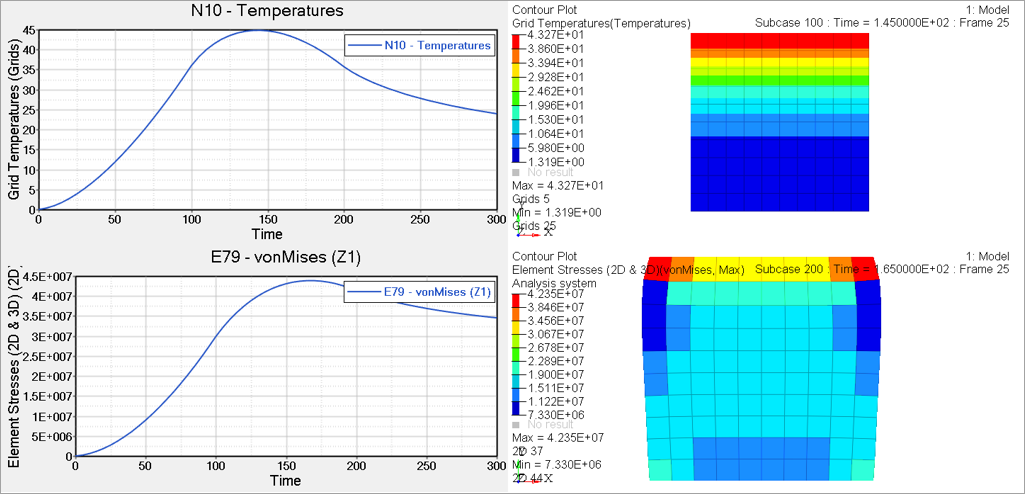One Step Transient Thermal Stress Analysis
Temperature history is available after a Linear Transient Heat Transfer Analysis or Nonlinear Transfer Heat Transfer Analysis. One Step Transient Thermal Stress Analysis (OSTTS) is used to apply this temperature history (at multiple output time steps) to a Structural Analysis.
- For a linear OSTTS solution, after the transient heat transfer run, multiple linear static subcases are internally spawned (equal to the number of thermal loads from transient heat transfer) and the stress state is calculated for each output time-step based on the applied temperature loads.
- For a nonlinear OSTTS run, the temperature from the preceding Transient Heat transfer Analysis is mapped linearly to the nonlinear static analysis subcase in the time domain as thermal load.
Linear and nonlinear OSTTS runs provide displacement and stress history for the duration of transient heat transfer. To capture the stress history accurately, you do not need as many time steps as Transient Heat Transfer Analysis. It is recommended to keep the number of output time steps (internal subcases) less than 50. When MUMPS solver is used, the upper limit for the number of boundary conditions is 200.
Fixed Initial and Final Time Temperature Mapping (HTIME=ALL)
SUBCASE 100
TITLE = Transient thermal subcase
ANALYSIS = HEAT
THERMAL(sort1, punch)=ALL
FLUX=ALL
TSTEP = 100
IC = 20
DLOAD = 200
$
SUBCASE 200
TITLE = One step transient thermal stress subcase
SPC = 1
TEMP(LOAD,HTIME=ALL) = 100
DISPLACEMENT=ALL
STRESS=ALL
Figure 1. Temperature History and Peak Stress of One Step Transient Thermal Stress Analysis
Flexible Initial and Final Time Temperature Mapping (TEMPT)
- An internal transient thermal subcase (HSUB). The thermal
load is mapped into the Nonlinear Static Analysis or Nonlinear Transient
Analysis linearly from the transient thermal analysis in time domain. The
mapping rule is defined in TEMPT card. Below is a sample
input deck for nonlinear OSTTS in ‘TEMPT’ format with
HSUB.
SUBCASE 100 TITLE = Transient thermal subcase ANALYSIS = HEAT THERMAL(sort1, punch)=ALL FLUX=ALL TSTEP = 100 IC = 20 DLOAD = 200 $ SUBCASE 200 TITLE = Nonlinear One step transient thermal stress subcase SPC = 1 NLPARM = 50 TEMP(LOAD,TEMPT) = 300 TEMP(INIT) = 60 DISPLACEMENT=ALL STRESS=ALL BEGIN BULK TEMPT,300,HSUB,100 TEMPD,60,10.0 - An external file (HFILE). The thermal load is mapped
into the Nonlinear Static Analysis or Nonlinear Transient Analysis linearly
from the external file in time domain. Currently, only PUNCH files are
supported as external temperature sources. The mapping rule is defined in
TEMPT card. A transient heat transfer subcase is not
required for the case where an external file (HFILE option)
provides the thermal loads for mapping. Below is a sample input deck for
nonlinear OSTTS in ‘TEMPT’ format with
HFILE.
ASSIGN,HFILE,203,temp_results.pch SUBCASE 200 TITLE = Nonlinear One step transient thermal stress subcase SPC = 1 NLPARM = 50 TEMP(LOAD,TEMPT) = 300 TEMP(INIT) = 60 DISPLACEMENT=ALL STRESS=ALL BEGIN BULK TEMPT,300,HFILE,203 +,HTINI,0.2,HTFIN,0.8 TEMPD,60,10.0
Initial Temperature
- For Linear OSTTS and Nonlinear OSTTS in ‘HTIME=ALL’ format, the elemental initial temperature is taken from the reference temperature in its material card. Nodal initial temperature is the average of the initial temperature in the elements supporting the grid.
- If OSTTS analysis (HTIME=ALL format) is used to perform either linear or Nonlinear Static/Transient Analysis at all output time steps of Transient Heat Transfer Analysis. Transient Heat Transfer Analysis outputs temperature results for every time step by default. This can lead to high run times and possibly generate large result files. It is recommended to use the skip factor (NO# field) on the TSTEP entry to control the number of time steps at which temperature results are saved for output, such that OSTTS analysis can still capture the stress history without significant computational cost.
- For Nonlinear OSTTS, the incremental step in Nonlinear Static Analysis and the output step of transient heat transfer analysis do not need to match each other. The incremental output of Nonlinear Static/Transient Analysis is controlled by the NLOUT entry.
- DLOAD entry in Nonlinear Static Analysis is not supported for Nonlinear OSTTS.